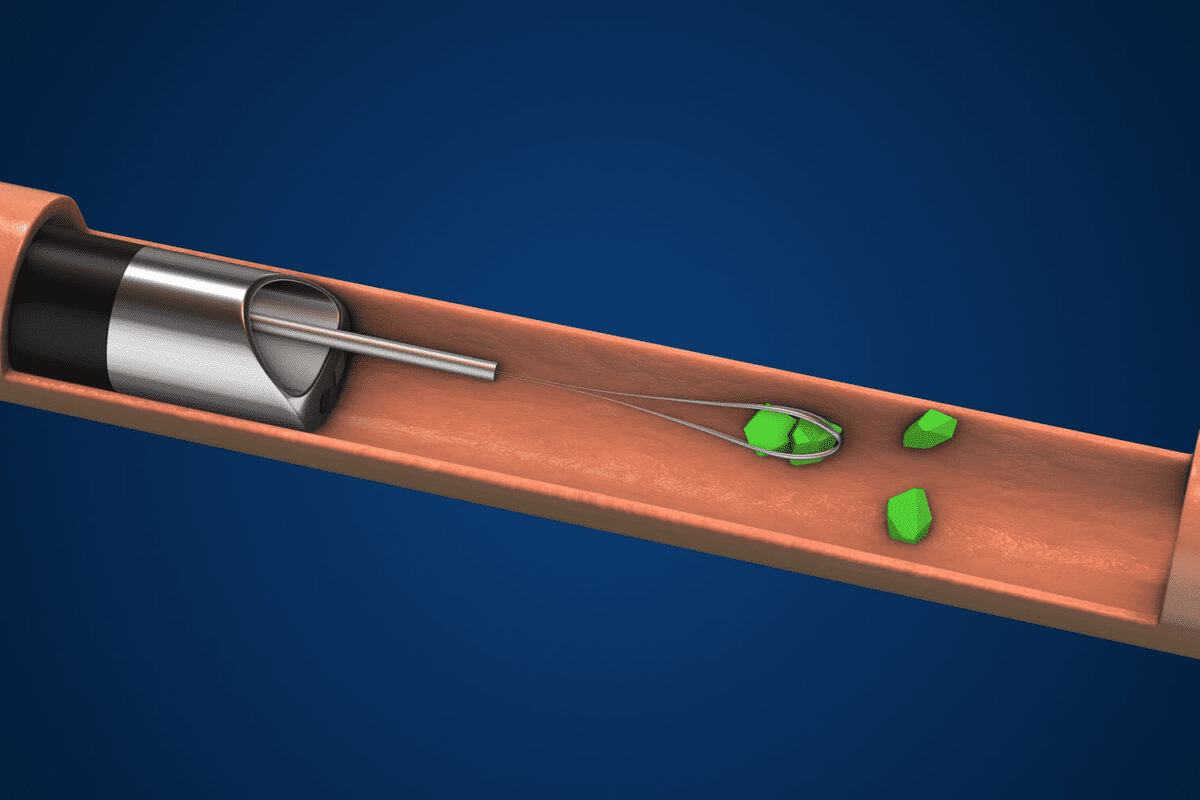Last Updated on October 31, 2025 by Bilal Hasdemir

Kidney stones can be very painful. Lithotripsy is a new way to treat them without surgery. It uses shock waves to break stones into smaller pieces that can pass easily.
The word “lithotripsy” comes from Greek. It means “stone” and “to break.” At Liv Hospital, we see lithotripsy as a key part of modern medicine. It shows how we can help patients without harming them.
The lithotripsy definition: a medical procedure that uses shock waves to break kidney stones into small pieces for easy passage.

Lithotripsy is a medical treatment that breaks down stones in the body. It’s a key term in the medical field. Knowing its meaning helps us understand how it works.
The word “lithotripsy” comes from Greek. ‘Lithos’ means stone, and ‘tripsy’ means to crush. This tells us lithotripsy is about breaking stones into smaller pieces.
French doctor Charles Louis Stanislas Heurteloup first used the term. He replaced “lithotrity” with it. This change is mentioned in “On the new method of destroying vesical calculi, by means of percussion … from a memoir by Baron Heurteloup,” in The Lancet. This shows how lithotripsy evolved.
“The introduction of lithotripsy marked a significant shift in the treatment of kidney stones, providing a less invasive option.”
Lithotripsy is a non-invasive way to treat urinary system stones, like kidney stones. It uses shock waves to break stones into smaller pieces. These pieces can then pass through the urinary tract without more surgery.
The main goal of lithotripsy is to relieve pain and remove stones. This prevents future problems. Knowing what lithotripsy does helps patients understand its benefits and risks.
Lithotripsy is important in modern medicine because it’s a painless and effective treatment. As technology improves, lithotripsy will likely keep playing a big role in treating stones.

The way we treat kidney stones has changed a lot over time. For ages, people with these stones had to go through painful treatments that didn’t always work. Now, we have much better, non-invasive methods.
Old treatments for kidney stones were very painful and risky. Open surgery was common, needing big cuts and long recovery times. These methods made patients very sick and kept them in the hospital for a long while.
Before lithotripsy came along, treating big or complex stones was hard. New, less invasive ways to treat them were a big step forward for patients.
Extracorporeal shock wave lithotripsy (ESWL) changed everything in the 1980s. It breaks stones down without surgery. Now, ESWL is a key part of treating kidney stones, making treatments safer and less invasive.
Lithotripsy was a game-changer, bringing a non-invasive option for kidney stone treatment. It cut down on recovery times and made treatments better, marking a big change in how we handle stone disease.
Lithotripsy procedures have grown in number, giving patients more options for treating stone diseases. This growth comes from new medical technology and a better understanding of the conditions.
Extracorporeal Shock Wave Lithotripsy (ESWL) is the most common type. It uses shock waves from a machine to break stones. This method is non-invasive, meaning no cuts are needed.
The procedure uses X-ray or ultrasound to guide the shock waves. Its non-invasive nature lowers the risk of problems and speeds up recovery.
Percutaneous Nephrolithotomy (PCNL) is more invasive than ESWL. It involves a small incision in the back for a nephroscope. This lets doctors directly access the kidney to remove or break up stones.
PCNL is best for large stones that ESWL can’t handle. It’s done under general anesthesia, with close monitoring.
Ureteroscopic Lithotripsy uses a thin, flexible scope to reach the ureter. It’s very effective for stones in the ureter.
The scope lets doctors see the stone and use laser to break it. Then, the pieces can pass out of the body easily.
Each lithotripsy method has its own benefits and risks. The right choice depends on the stone’s size, location, and type, and the patient’s health.
Lithotripsy works by using shock waves to break down stones. This method is non-invasive and treats many types of stones. These include kidney, gall, pancreatic duct, and bile duct stones.
Lithotripsy uses a device called a lithotripter to create shock waves. The most common type is the electrohydraulic lithotripter. It makes shock waves by sparking water, turning it into vapor.
The focusing mechanism is key. It makes sure the shock wave hits the stone right, without harming nearby tissue.
The focusing system uses an ellipsoidal reflector. It focuses the shock wave on a point where the stone is. This precise aim helps break down the stone without harming the area around it.
The process of breaking down stones in lithotripsy involves complex physics. When a shock wave hits a stone, it creates stress. This stress breaks the stone into smaller pieces.
The main ways this happens are:
The mix of these mechanisms effectively crushes stones. This allows them to pass or be removed. Knowing the physics of lithotripsy helps make treatments better and improves results for patients.
Lithotripsy is a non-invasive treatment for many medical conditions. It helps treat stone-related issues, improving patient care and shortening recovery times.
Kidney stones are a common target for lithotripsy. This method is great for stones that can’t pass on their own or cause a lot of pain. Extracorporeal Shock Wave Lithotripsy (ESWL) breaks down stones into smaller pieces that can pass easily.
Most patients see big improvements after lithotripsy for kidney stones. It has greatly reduced the need for surgery for these stones.
Lithotripsy also treats gallstones, mainly for those who can’t have surgery. Extracorporeal Shock Wave Lithotripsy is used to break up gallstones, but it’s less common than for kidney stones. It’s usually for patients with a few large gallstones.
Condition | Treatment Approach | Success Rate |
Kidney Stones | ESWL | 80-90% |
Gallstones | ESWL | 70-80% |
Pancreatic Duct Stones | ERCP-guided lithotripsy | 85-95% |
Pancreatic and bile duct stones can also be treated with lithotripsy. These stones can cause a lot of pain and problems like pancreatitis. Endoscopic Retrograde Cholangiopancreatography (ERCP)-guided lithotripsy is used to target and break down these stones precisely.
Researchers are looking into new uses for lithotripsy, like treating vascular diseases and breaking down calcified plaques. These ideas are in the early stages but could be big for the future of lithotripsy.
As medical tech gets better, we’ll see more from lithotripsy. Its ability to treat many conditions without surgery makes it very appealing.
The success of lithotripsy greatly depends on choosing the right patients. We look at many factors to make sure the treatment is safe and works well.
Finding the right patients for lithotripsy is key. Those with specific types of kidney stones are usually good choices. We check the stone’s size, location, and type.
Good candidates have stones that are:
Lithotripsy works well for many, but it’s not for everyone. Some medical conditions or body types make it not suitable.
Condition | Reason for Contraindication |
Pregnancy | Risk of harm to the fetus |
Uncontrolled bleeding disorders | Risk of bleeding complications |
Severe obesity | Difficulty in focusing shock waves |
Before lithotripsy, patients go through tests and steps to get ready. These include:
We also tell patients about diet and other steps to make the procedure go smoothly.
Lithotripsy is usually done as an outpatient procedure. It takes about 45 to 60 minutes. Choosing the right patients and preparing them well is key to success.
Lithotripsy is a simple process with several steps. We help our patients through each step for a smooth treatment. This ensures a successful outcome.
Before lithotripsy, patients have tests to see if they’re good candidates. These tests find the stone’s location and size. They also check the stone’s type.
Patients must tell their doctor about any health issues. This includes heart problems or pacemakers. We give detailed instructions on how to prepare, including diet and medication changes.
During lithotripsy, patients lie on a table. Shock waves are then applied to the stone. The whole process takes about 45 to 60 minutes.
The machine breaks the stone into small pieces. These pieces can then pass through urine. Patients might feel some discomfort, but we make sure they’re comfortable.
After lithotripsy, patients are watched for any immediate issues. We give them tips on managing pain and discomfort. This includes advice on pain relief medication.
We also tell patients how to help pass the stone fragments. This includes drinking lots of water and possibly taking medication. We check on their progress with follow-up appointments.
Care Aspect | Description | Recommendation |
Pain Management | Management of discomfort or pain | Prescribed pain relief medication |
Hydration | Drinking plenty of water | At least 8-10 glasses a day |
Follow-Up | Scheduling follow-up appointments | As advised by healthcare provider |
Lithotripsy has changed how we treat kidney stones. It’s a non-invasive and effective treatment. Many patients have little downtime and quickly return to their normal lives.
“The lithotripsy procedure was a game-changer for me. I was back to my normal routine within a few days.”
A patient after undergoing lithotripsy
Knowing what to expect after lithotripsy is key. Recovery times can vary, but most people get back to normal quickly. It’s important to listen to your doctor’s advice to make the recovery smoother.
Most people can start doing light activities a day or two after lithotripsy. But, it’s vital to stick to your doctor’s post-procedure instructions. This helps ensure a smooth recovery.
Keep an eye on how you’re feeling and talk to your doctor if something seems off. Passing stone fragments is a big part of getting better. Be ready for this.
Lithotripsy works well for most people, breaking up stones effectively. How well it works depends on the stone’s size and location, and your overall health.
Research shows lithotripsy is very effective, with success rates between 70% and 90%. Here’s a table showing success rates based on stone size:
Stone Size | Success Rate |
Less than 1 cm | 85% |
1-2 cm | 75% |
Greater than 2 cm | 60% |
Passing the stone fragments is the most important part of recovery. You might feel some pain, but it’s usually manageable with medication.
Drink plenty of water and eat well to help pass the fragments. Most people do fine, but it’s important to check in with your doctor to make sure everything went well.
It’s important for patients to know about the risks and side effects of lithotripsy. This helps them decide the best treatment for them. ESWL has both good and bad points.
Most people who get lithotripsy face some side effects. These are usually mild and don’t last long. Common issues include:
Doctors usually treat these side effects with pain meds, antibiotics, or other care. “Most patients do well with lithotripsy,” doctors say. “These side effects usually go away in a few days.”
Though rare, serious complications can happen with lithotripsy. These include:
It’s key for patients to know about these serious issues. They should talk to their doctor about any worries.
Most people fully recover from lithotripsy without lasting effects. But, some might face:
Seeing a doctor regularly is a good idea to catch any long-term problems. It’s important to weigh the good and bad of lithotripsy for each person.
Knowing about the risks and side effects of lithotripsy helps patients make smart choices. It prepares them for what to expect during treatment.
Lithotripsy is a big step forward in treating kidney stones and other health issues. It’s a noninvasive method that’s safe and effective. This makes it a great alternative to old surgical ways.
The process of lithotripsy uses shock waves to break down stones. This helps them pass out of the body naturally. It’s a key part of modern medicine, helping patients recover quickly and avoiding serious problems.
Learning about lithotripsy shows us its many benefits for people everywhere. It’s a groundbreaking treatment that keeps getting better. New improvements are being made to make it even more effective and useful for more health issues.
Lithotripsy is a noninvasive medical procedure. It uses shock waves to break kidney stones into smaller pieces. These pieces can then be passed out of the body easily.
The term lithotripsy comes from Greek words. “Lithos” means stone, and “tripsy” means crushing. It refers to the medical procedure of crushing stones, like kidney stones, using shock waves.
Lithotripsy works by using shock waves. These waves are focused on the kidney stone. This causes it to break into smaller pieces. These pieces can then be passed out of the body through the urinary tract.
There are several types of lithotripsy procedures. These include Extracorporeal Shock Wave Lithotripsy (ESWL), Percutaneous Nephrolithotomy (PCNL), and ureteroscopic lithotripsy. Each procedure has its own unique characteristics and applications.
While some patients may feel discomfort or pain during or after lithotripsy, it’s generally not very painful. Pain management options are available to help reduce any discomfort.
Common side effects of lithotripsy include bruising, pain, and discomfort. Rare but serious complications can include infection, bleeding, and damage to surrounding tissues.
Recovery time after lithotripsy varies. It depends on the individual and the type of procedure. Generally, patients can return to normal activities within a few days to a week.
Yes, lithotripsy can treat other conditions like gallstones and pancreatic duct stones. It’s also being explored for other medical uses.
The success rate of lithotripsy depends on several factors. These include the size and location of the stone, and the type of procedure. Generally, it’s a highly effective treatment for kidney stones.
Preparation for lithotripsy involves pre-procedure testing, like imaging studies. You’ll also follow specific instructions from your healthcare provider.
In medical terms, lithotripsy is a noninvasive procedure. It uses shock waves to break stones, like kidney stones, into smaller pieces that can be easily passed out of the body.
The medical term for crushing of stones is lithotripsy.
The medical term for stone fragmentation is lithotripsy. It involves breaking stones into smaller pieces using shock waves.
Sivarajan, G., & Masterson, T. A. (2014). Ten-year Outcomes of Sexual Function After Radical Prostatectomy. European Urology, 66(2), 222-230. https://www.sciencedirect.com/science/article/abs/pii/S0302283813008476
Subscribe to our e-newsletter to stay informed about the latest innovations in the world of health and exclusive offers!
WhatsApp us